CREATIVE VALLEY
by Danielle Vigueria and Sabina Dana Plasse
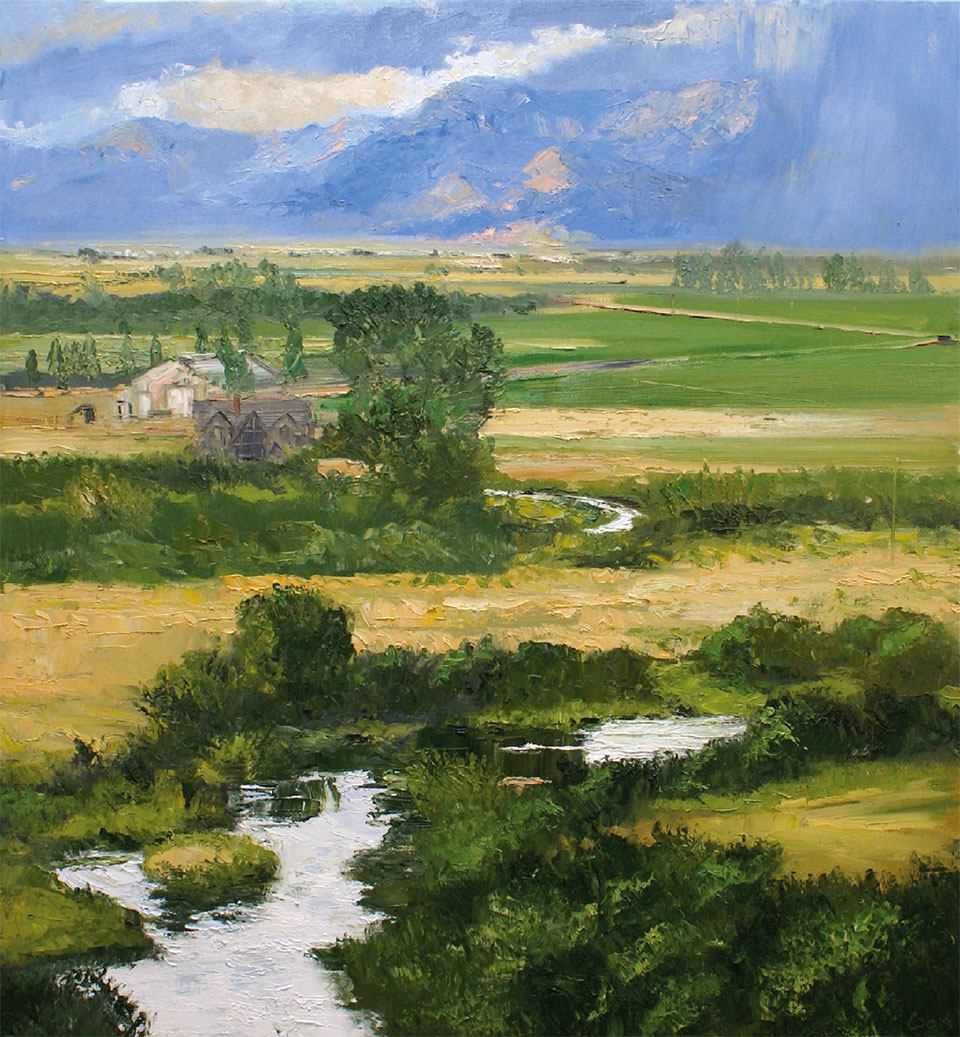
Afternoon Rain Showers – Silver Creek | oil on canvas | 52”x 48” | James Cook
Art & Artisans in Sun Valley
Earlier this year, Forbes published an article highlighting several trends to look for in the art market. They highlighted street art, collaborations, and collectibles. In a similar piece published in March, digital concepts dominated three of the top five trends that Sotheby’s is seeing in the art market this year. While some collectors gravitate toward the newest artists with fresh voices responding to the issues of our times, others seek timeless classic work.
WHJ is proud to present four local art businesses that offer a range of work to suit diverse tastes. From decorative concrete to nationally-renowned fine art galleries, our selections highlight some of the most creative artistic talents that Sun Valley offers:
+ Custom decorative concrete from Cliffhangers, Inc.
+ Paintings and sculpture from Gail Severn Gallery
+ Fine art photography from Mountain Images Gallery
+ Framing, installation, and restoration from Art Doctor
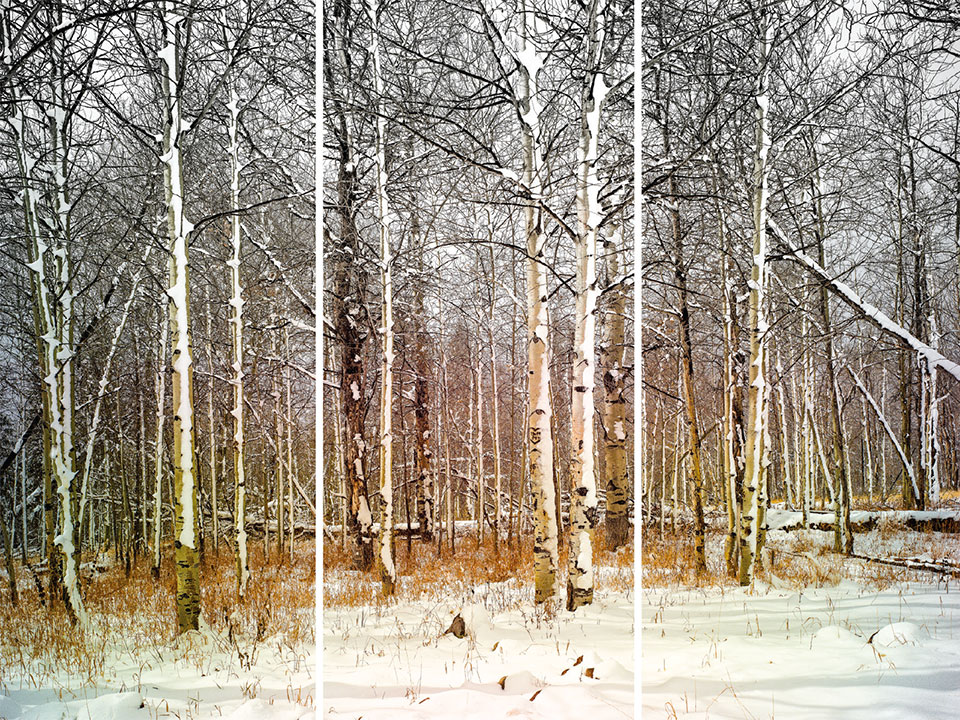
First Snow | photograph on canvas | 60”x 84” (other sizes available) | James Bourret
Jon Nasvik
Fine Art Meets Concrete
by Danielle Vigueria
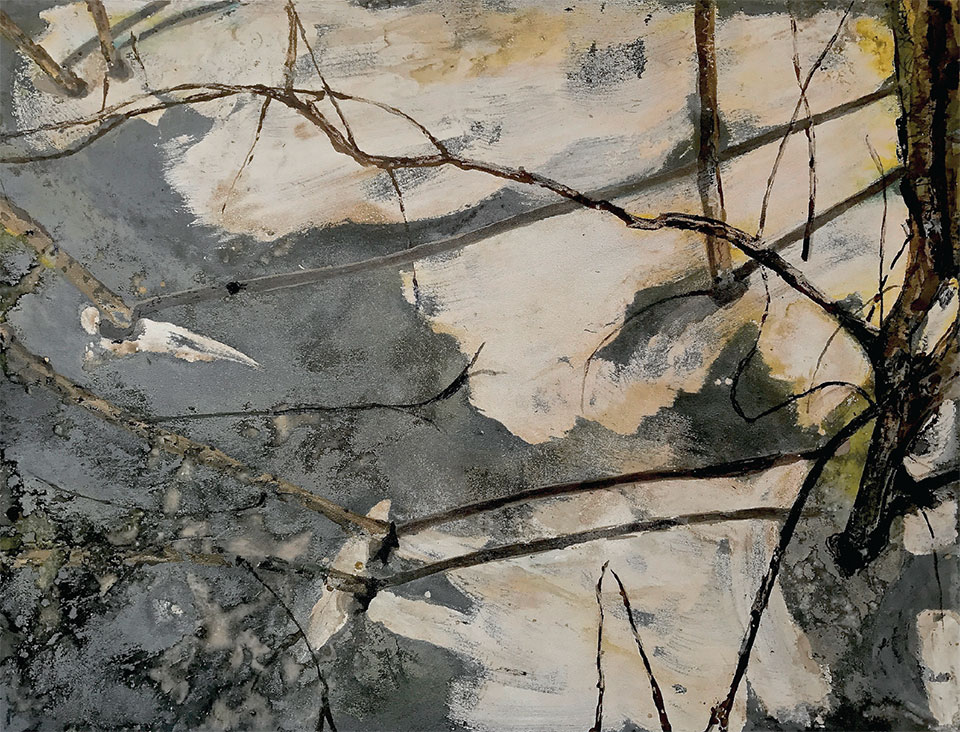
Spring Thaw | concrete | 24”x 32” | Jonathan Nasvik
“I knew in elementary school that I wanted to be an artist. Fine art was my passion, my major in college, my identity, but I sidelined pursuing it professionally because concrete paid my bills.”
–Jon Nasvik
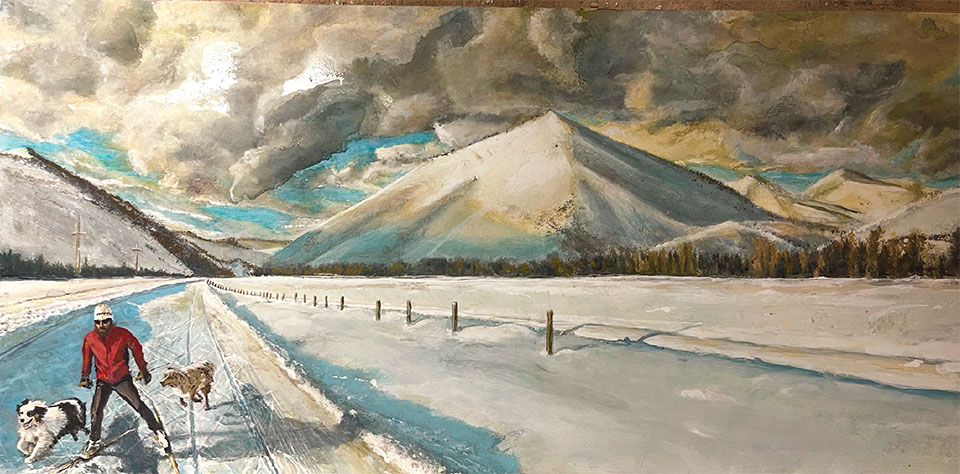
Evening Ski | concrete | 29”x 58” | Jonathan Nasvik
Jonathan Nasvik has been creating custom, decorative concrete pieces as the owner and operator of Cliffhangers, Inc. for more than 30 years. His contracting business specializes in artfully using cement products and has served national parks, zoos, and commercial and residential spaces. He has brought a sculptural touch to hundreds of installations such as fireplaces, outdoor furniture, and artificial rock formations including waterfalls and climbing walls.
Having started in the concrete business in the 1960s, pushing wheelbarrows and slinging mud in his home state of Minnesota, Jon has become an expert with the medium. “I enjoy working with concrete because it’s an incredibly versatile medium,” says Jon. “I can’t think of another building material that has so many different functional and aesthetic applications.”
But recently, Jon has begun to explore a calling from his past. “I knew in elementary school that I wanted to be an artist,” he says. “Fine art was my passion, my major in college, my identity, but I sidelined pursuing it professionally because concrete paid my bills, and because my path eventually morphed into ‘decorative concrete.’ Creative backyard patios drew interest from customers looking for something different and my career progressed from then to now. After all these years doing concrete work, I still live and breathe the persona of an artist. I’m 71. Reality is pressing down. The sacks of cement are getting heavier.”
Today, Jon is combining his concrete expertise with his artistic aspirations. He has developed a personal technique for transforming concrete into exceptional fine art. He produces pieces that are incredibly refined; at first glance, it is difficult to believe they are not paint on canvas. “It’s taken a lot of years working in concrete to get to this point,” says Jon. “About five years ago I made my first attempt at fine art from cement and I saw my future. Concrete can present in so many different ways; I am constantly discovering greater potential. This is exciting. I feel I’ve reached a point where I’m onto something very interesting, with incredible creative value.”
According to Jon, concrete is a particularly good medium for fine art. There are many things that can be accomplished with it that just can’t be achieved with paint. It lends itself to more aggressive textures; it can be polished to the smoothness and sheen of glass; artists can build it up, cut or crack it, saw it, grind it, integrally color and stain it, and imbed objects in it. Concrete can also present a lot like watercolor and/or mimic oil paint. It is hard and durable enough to withstand the elements. No doubt, more will be discovered during “future work,” suggests Jon.
“I have always been interested in the alchemy that exists between nature and art. With COVID, the importance of a strong immune system is critical. As I was working to build my own immune system, the thought came to me that I should include these elements in my paintings so the world could reflect on the importance of our natural foods.”
–Susan Swartz
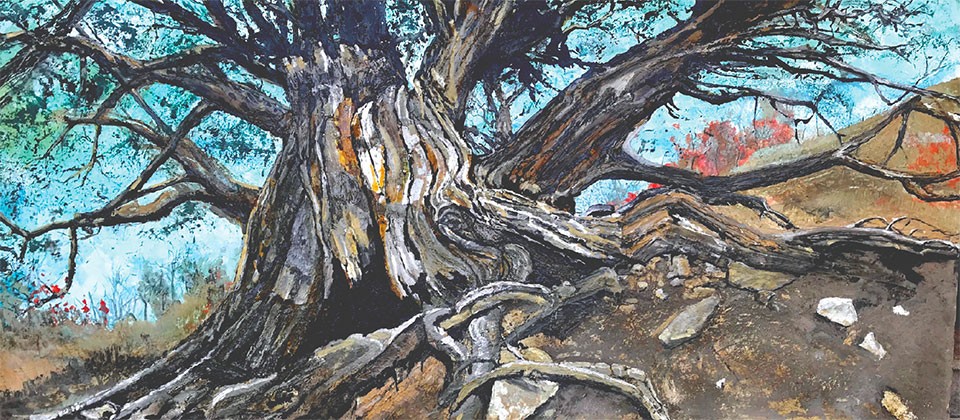
High Country Ancient | concrete | 96”x 44” | Jonathan Nasvik
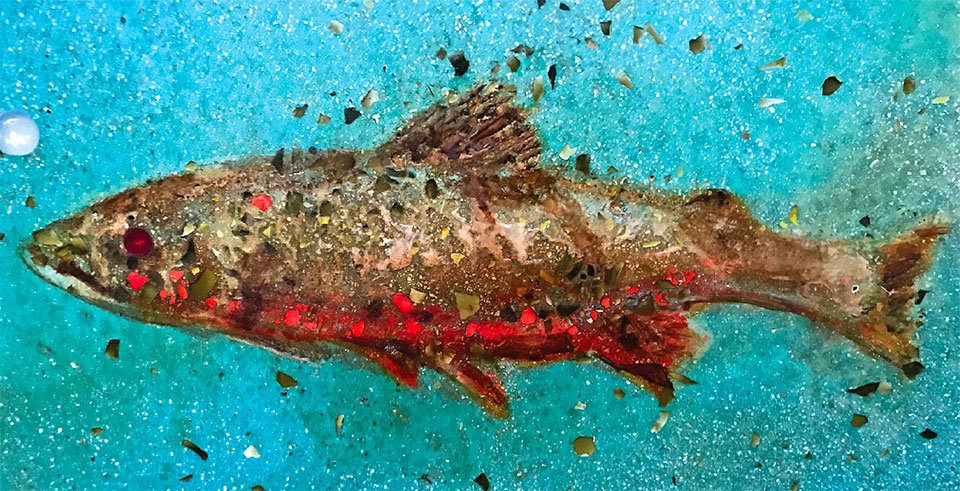
Mosaic Trout | concrete | 9”x 16” | Jonathan Nasvik
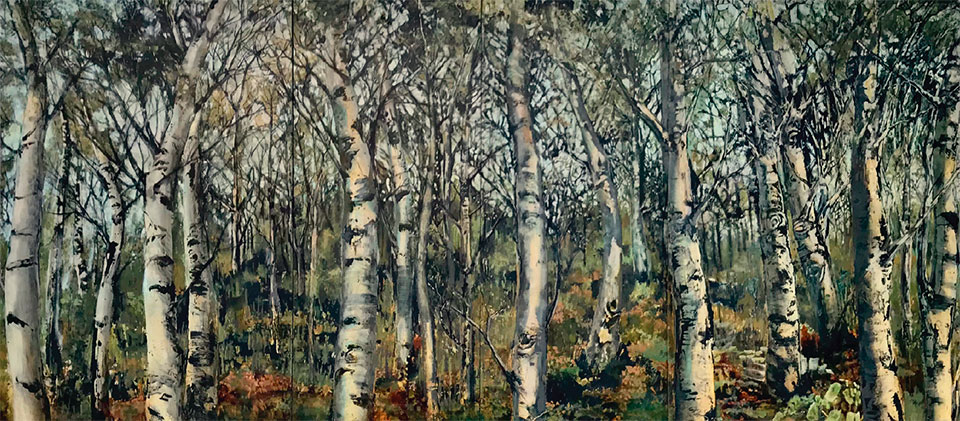
Aspen Shower | concrete | 84”x 168” | Jonathan Nasvik
“As I progressed, I learned how to make concrete lightweight and thin. And that led to me exploring solutions for my goals. Like casting metal hangers on the back so it can be hung freely and loosely. The resulting piece is concrete art that almost reads like fabric.”
–Jon Nasvik
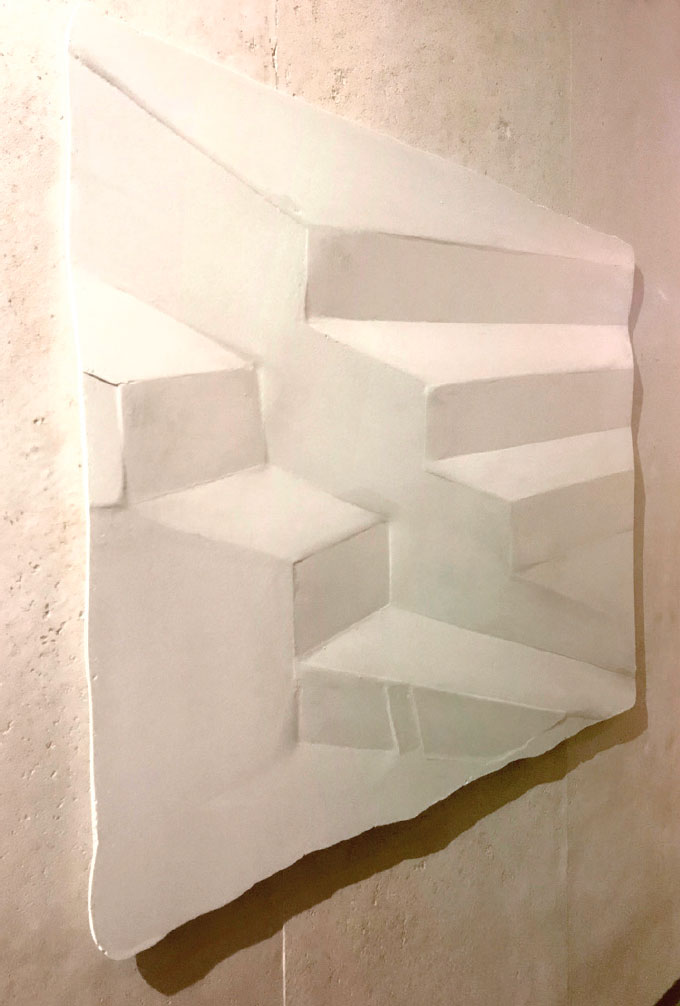
Steps | concrete | 45”x 60” | Jonathan Nasvik
The key to hanging his art on typical walls is in making concrete extremely thin and lightweight. Jon’s earlier work included half-inch-thick concrete panels for transportable precast countertops and wall panels, as well as sinks and bathtubs, but after years of finesse, Jon is now creating artwork that is entirely made from concrete, measuring only 1/8” thick. Over time he has also embraced a more free-flowing approach, moving away from the constraints of a formally defined space and allowing the edges freedom to end wherever they choose.
“Originally I took a traditional point of view about how art is displayed,” says Jon. “Now I have questions about frames. ‘Do they compete with the artwork?’ Ideally, the two should work together but they don’t always. Same goes for the boundary. ‘How does it define the presentation? And what about the surface? How much relief should it have before it becomes a sculpture?’ As I progressed, I learned how to make concrete lightweight and thin. And that led to me exploring solutions for my goals. Like casting metal hangers on the back so it can be hung freely and loosely. The resulting piece is concrete art that almost reads like fabric.”
An advocate for the environment, much of Jon’s work is inspired by nature and showcases representational and contemporary styles. Currently, he is creating a piece depicting a large elk moving through snowy brush. Camouflaged by a screen of branches, it was inspired by the idea that, often, unnoticed wildlife is all around us. He hopes to bring awareness with his art to the natural beauty found in everyday life.
As for the future, Jon doesn’t seem to be slowing down any time soon. Having reignited his interest in fine arts, he expects to continue pursuing this new form of expression, which means that, to a limited extent, he could be “lugging 100-pound sacks of cement” for years to come.
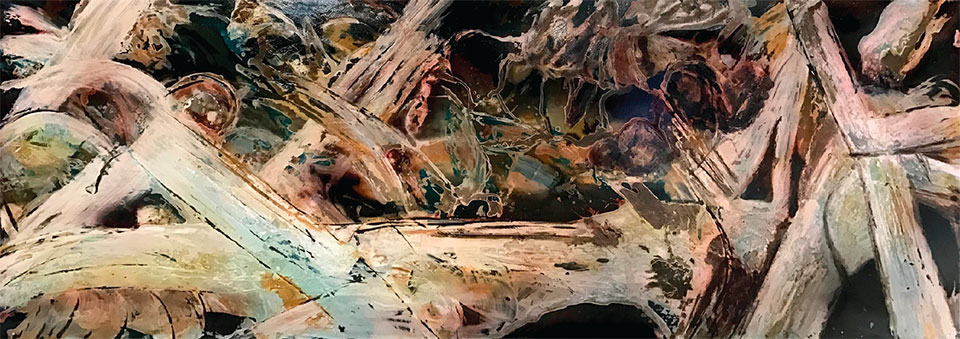
Astral Landscape | concrete | 30”x 84” | Jonathan Nasvik
Gail Severn Gallery
Honoring Core Creativity
by Sabina Dana Plasse
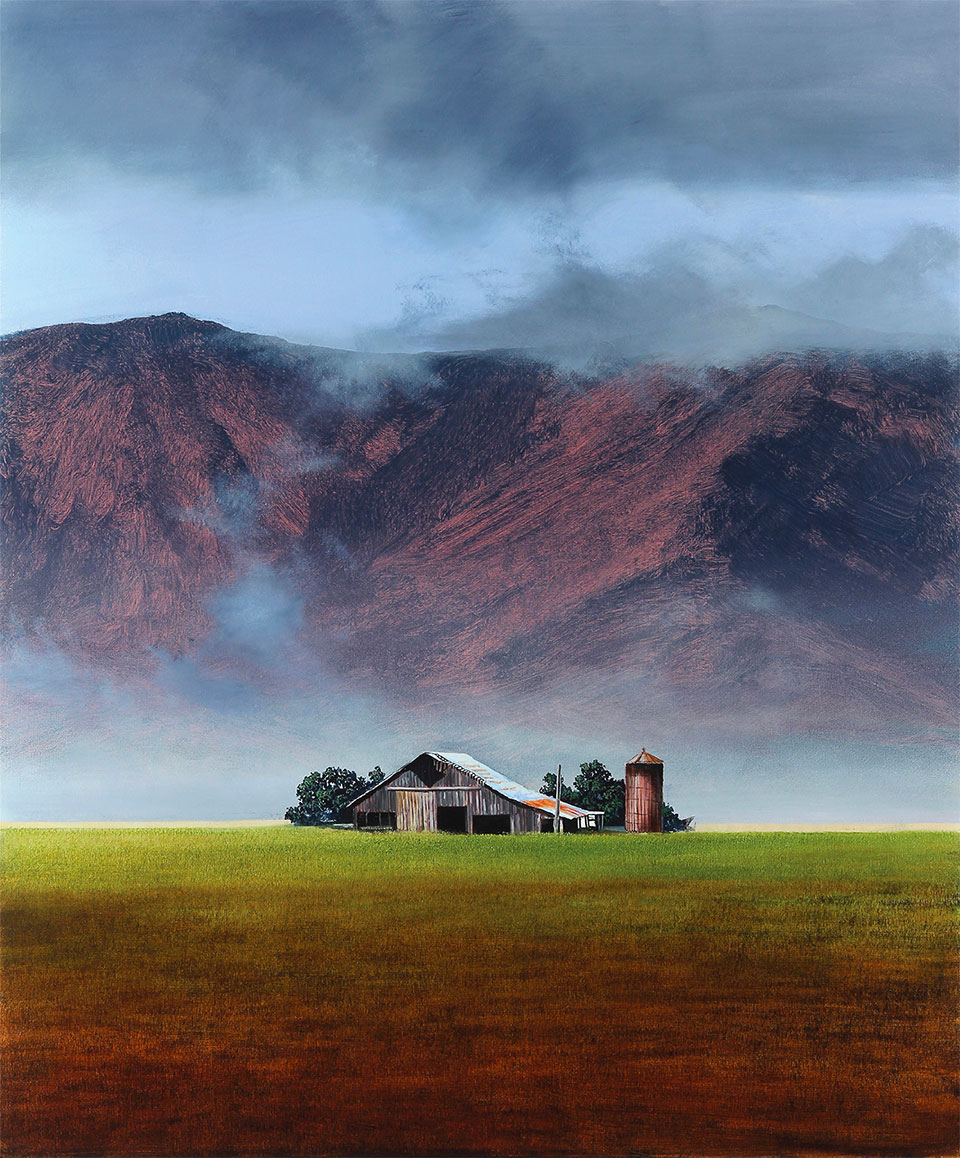
Bound Away | Oil on canvas/panel | 60”x 50” | Michael Gregory
Summer exhibitions feature living artists and legacy fine art.
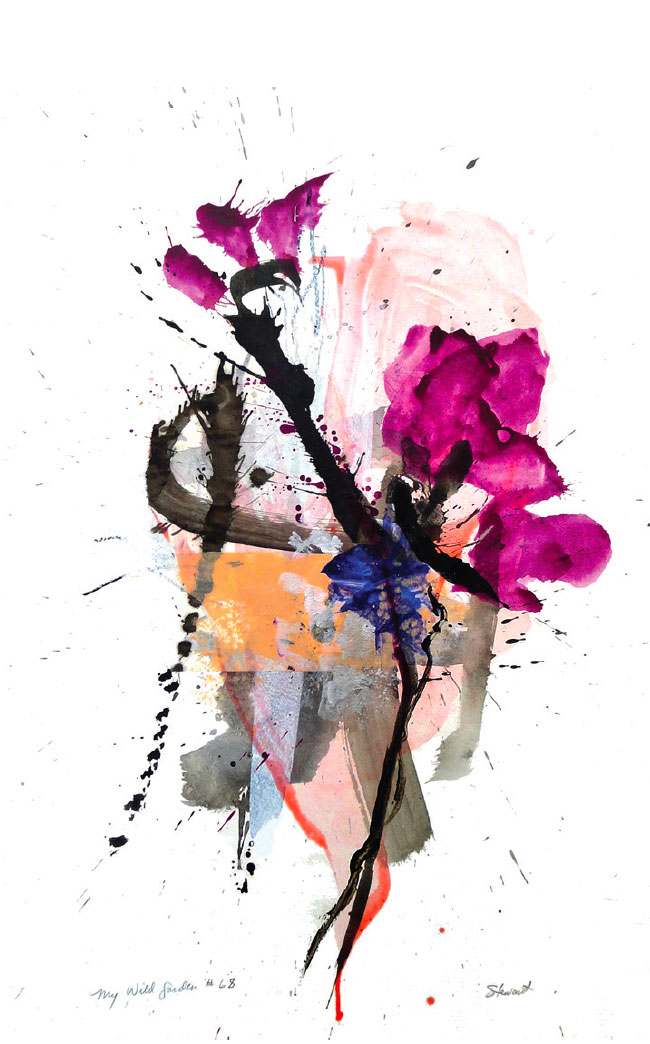
My Wild Garden #68 | mixed media on rag paper | 36”x 28” | Allison Stewart
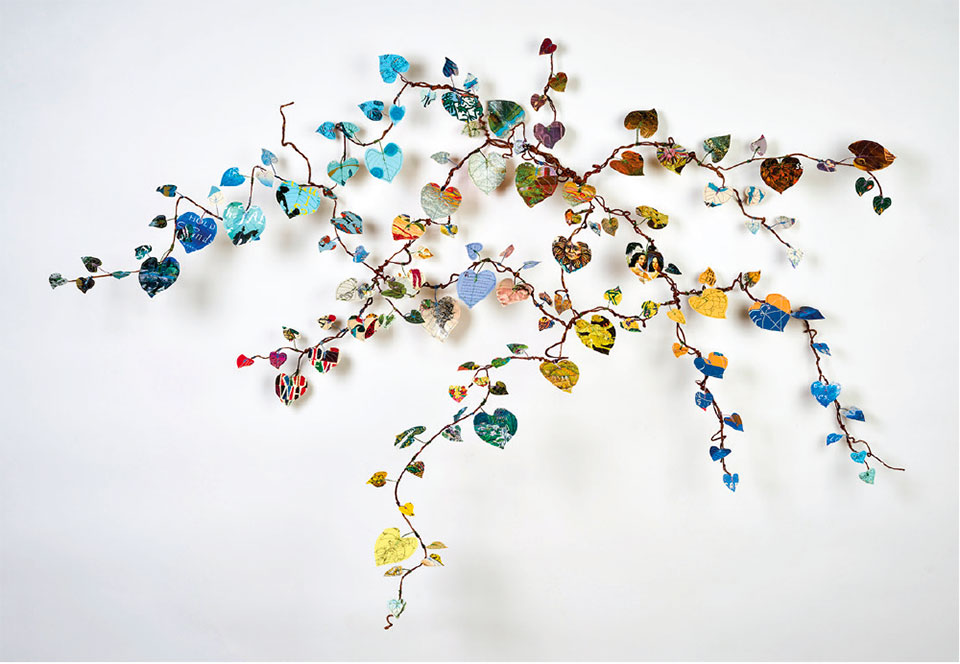
Cordifolia 2 | paperback book covers, thread, mull | 41”x 60”x 14” | Lisa Kokin
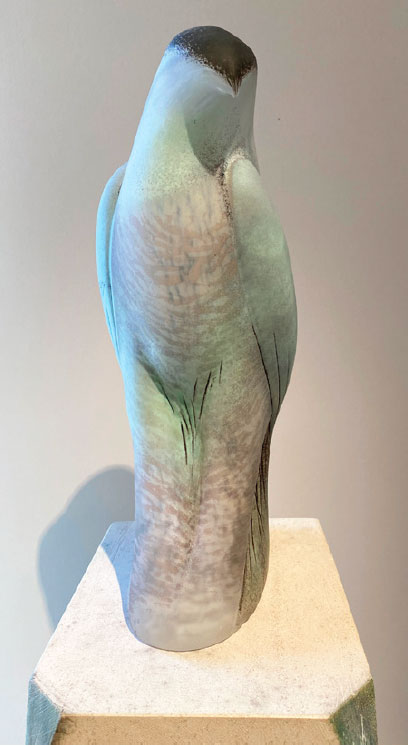
Norma’s Celadon Water Bird | Handblown pigmented glass on limestone | 63”x 10”x 8” | Jane Rosen
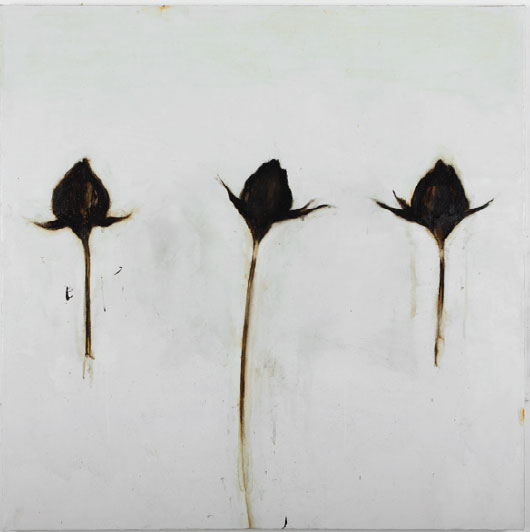
Untitled #534 | Oil on linen | 72”x 72” | Kathy Moss
Gail Severn Gallery is one of Ketchum’s most extensive exhibition spaces. It can present multiple shows and spotlight artists with extended viewing areas throughout its four exhibit rooms. Though many galleries present work by living and working artists, it’s also about supporting legacies for Gail Severn, owner of Gail Severn Gallery. This summer, the gallery features a group exhibition, Flora & Fauna, a Hung Liu memorial show, Past as Prologue, and new works by Laura McPhee, a fine art photographer who lives in the Wood River Valley.
Group Exhibition | Flora & Fauna
For summer 2022, the gallery will celebrate the summer season with a group exhibition, Flora & Fauna, with works by well-known gallery artists, including large paintings by Kathy Moss, Michael Gregory, James Cook, and Allison Stewart. In addition, the show will present smaller and more detailed, intimate works by Diane Andrews Hall and collages by Kenna Moser.
Flora & Fauna also includes artists Kara Maria, Chris Maynard, and Theodore Waddell, who offer their perspectives on animal life through abstract interpretations of providing an alternative vision of the natural world we live in. Accompanying these paintings are sculptors Jane Rosen, Gwynn Murrill, Carolyn Olbum, and Bean Finneran, who present the beauty of nature through unique materials including glass, bronze, and ceramics. Presenting nature in its stripped-down form, Flora & Fauna is a gathering of works that offers an emotional connection and appreciation to living in the West.
To walk around Gail Severn Gallery and encounter art through the eyes of artists guided by nature is an experience that communicates the attraction to nature and the need to be in nature. “Each of these artists is unique in their interpretation of nature,” says Gail. “You meet each artist in how they interpret nature, whether it is flowers or creatures, each in their own vernacular, which is so meaningful. As a gardener and someone who loves being in the outdoors, this work touches me deeply, and I know it will reach our audience as well.”
This exhibition runs in its entirety through late June. Many of the artists will continue to have work in the gallery throughout the summer and fall. Additional summer and fall exhibitions will include Ed Musante, who painted birds and animals on cigar boxes, and Gary Komarin, Rana Rochat, and Pegan Brook, who work with abstraction and color. The gallery will also feature Judith Kindler’s paintings, prints, and sculptures.
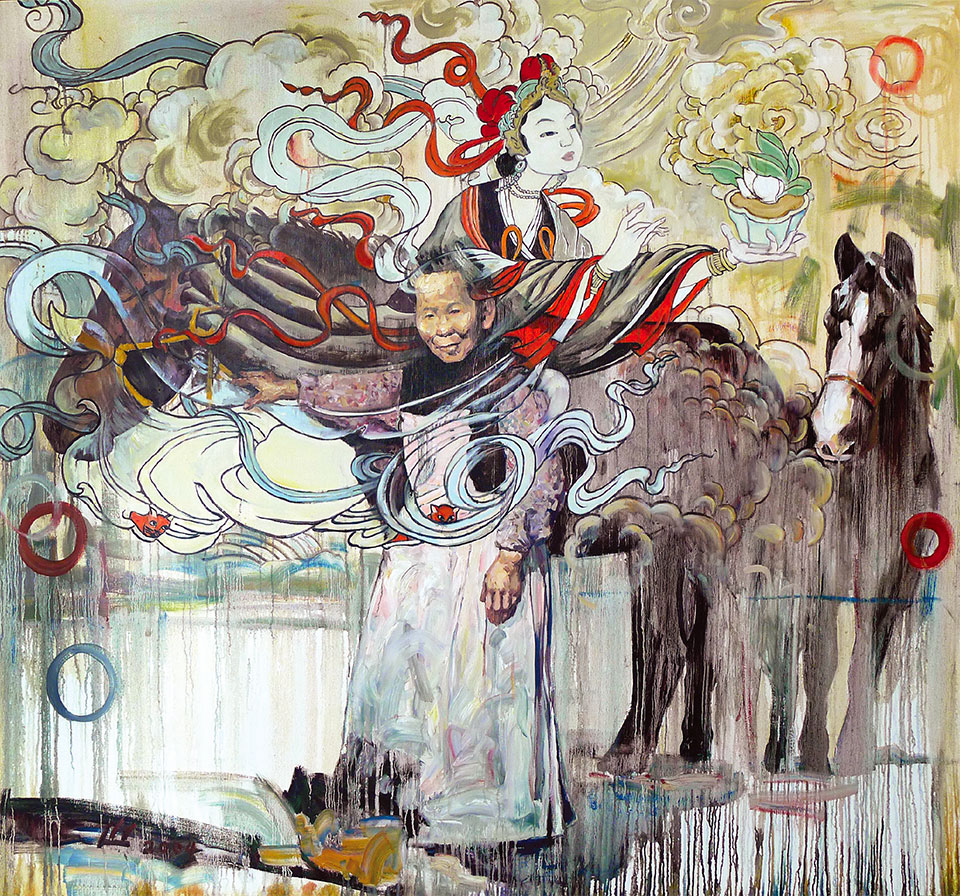
Polly Bemis | oil on canvas | 66”x 70” | Hung Liu
Hung Liu Memorial Exhibition Past As Prologue
Gail Severn Gallery is proud to present the first of two summer solo shows, Past as Prologue, honoring the life and work of acclaimed American and internationally renowned Chinese American artist Hung Liu who passed away in August of 2021. This memorial exhibition features a collection of Hung Liu’s oil paintings, mixed media work, photographs, and prints.
Liu’s work has been exhibited in over 80 museums worldwide, including her retrospective, Portraits of Promised Lands, at the National Portrait Gallery in Washington D.C.
In Portraits of Promised Lands, Hung Liu provides a parallel connection of marginalized people in the U.S. through her use of iconic images by Dust Bowl and Depression-era documentary photographer and photojournalist Dorothea Lange. Before she died, Liu was going to have a major exhibition in China, which was canceled due to censorship revealing the absence of free speech and denying her work in her homeland.
“Hung’s works have great meaning in the world,” says Gail. “Through her work, Hung
Liu drew attention to the large-scale oppression that appears throughout history regardless of place or time. Emigration and migration were significant themes to Hung Liu, and her painting spoke her truth – that she identified with the marginalized figures she painted. She would often paint dandelion seeds. Typically identified as an undesirable weed, dandelion seeds were a symbol of human resilience for Hung. She likened her emigrant experience to that of dandelion seeds that, by choice or chance, land in remote places, grow roots to bloom and thrive again.”
She would often paint dandelion seeds. Typically identified as an undesirable weed, dandelion seeds were a symbol of human resilience for Hung. She likened her emigrant experience to that of dandelion seeds that, by choice or chance, land in remote places, grow roots to bloom and thrive again.”
–Gail Severn
Liu is one of a few artists who received memorial tributes in The New York Times, The Washington Post, The Financial Times, and Wall Street Journal. “It’s rare for an artist to have such national acclaim, but Hung’s work speaks to our humanity, emphasizing our connection to each other, and past and future generations through the referencing of historical photographs and cultural iconography.
Highlighting historically marginalized figures, many of which were women, Liu surrounds her subjects with hopeful symbols of flowers, birds, and deity figurines, rewriting the historical narrative from one of oppression to one of hope, giving prominence to the many figures often ignored by history.
Hung Liu grew up in China’s Cultural Revolution and knew pain, suffering, and oppression. Yet, her work lives on as a connection to the world’s humanity. Paying homage to Hung Liu, the Gail Severn Gallery will present a wide selection of Hung Liu’s work, close to 40 works, including oil paintings, mixed media works, and historical photos and prints.
Laura McPhee
Drawn to how humans and nature exist with relationship to each other and the subsequent ramifications of existence, Laura McPhee captures the essence of a place in the eye of erosion, giving human beings the need to advance in society. Her work continues to identify the beauty of our surroundings and an understanding of its destruction, often elucidating human intervention within these scenes. Using her large-format Deardorff camera, she captures the essence of why nature is so fragile.
“Laura McPhee truly understands the complex relationship with Mother Earth,” says Gail. “We must take the impact that humans have had on the planet very seriously, and Laura wants to document all the places that show this in many ways. However, she also wants to document the beauty and fragility and will often reveal the impact of human intervention on these locations. Many of her images show a balance of human intervention but honor the beauty of the sheer landscape in intimate close-ups and wide-range vistas.”
Laura McPhee’s work has been exhibited in many museums, including the Amon Carter Museum, The Chrysler Museum of Art, The DeCordova Museum, The J. Paul Getty Center & Museum, The Kemper Museum of Contemporary Art, The Los Angeles County Museum of Art, The Peabody Essex Museum, and The Saint Louis Art Museum. She has had solo shows at The Boise Art Museum, Carnegie Museum, and the Museum of Fine Arts in Boston.
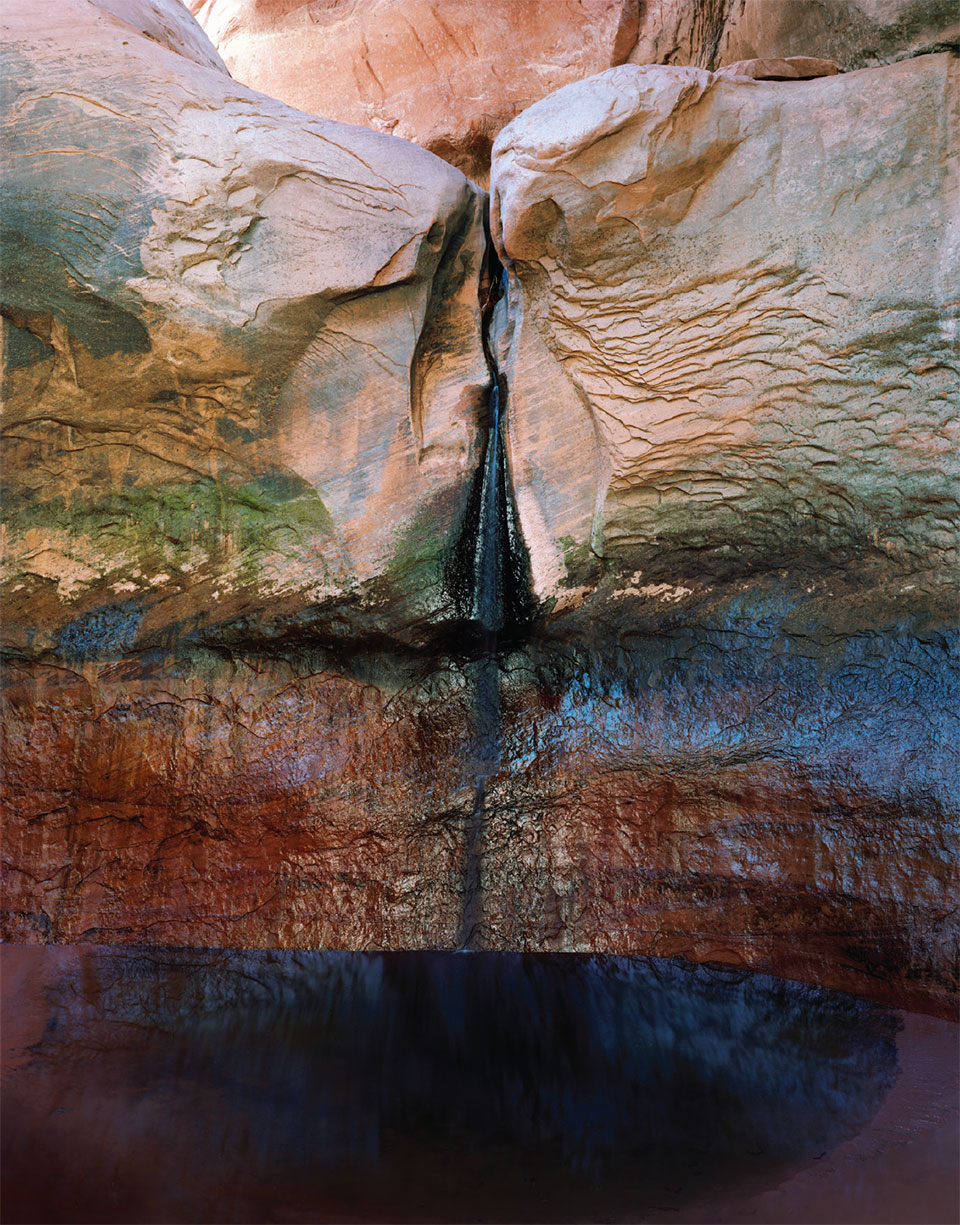
Abandoned Rope Swing, Lake Powell | archival pigment print | 40”x 50 | Laura McPhee
Mountain Images Gallery
James Bourret Fine Art Photography
by Danielle Vigueria
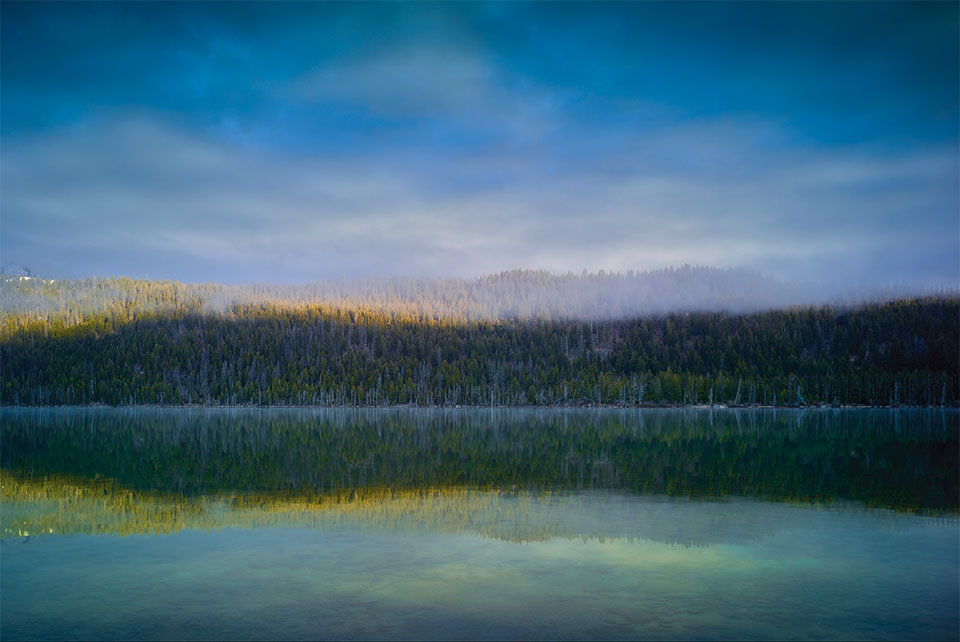
Redfish Morning #2 | Photograph on Canvas | 40”x 66” (other sizes available) | James Bourret
After three successful decades in architecture and design, James Bourret found his way back to his first artistic love: photography. Having explored the world through a camera lens in high school and college, shifting back again has been a natural transition. James believes that his formal design training now influences and enhances his skills as a photographer. Using his ability to think three-dimensionally, he composes vibrant, powerful images that masterfully play with the concepts of depth and space.
James’s return to photography began 12 years ago when he opened Mountain Images Gallery in downtown Ketchum. Over time, his art has evolved from pieces that complemented interior spaces to works of a size and scope that are the focal point of a room rather than a beautiful accent. Today, James is known for making immersive, large-scale triptych pieces that still maintain the integrity of the original image’s fine detail. A typical print measures 5.5 feet by 10 feet, with some of his largest pieces reaching 7 feet by 16 feet. His images are made using only photographic techniques and the highest quality archival printing methods and materials.
With a deep reverence for the natural world and driving desire to preserve it, James hopes to draw more people to nature through his large-scale, captivating photography. “I grew up with a lot of exposure to the outdoors, lots of hiking and backpacking,” says James. “Part of my motivation comes from wanting to share with others the beauty I have found through those experiences. Every new place is an inspiration, it’s the joy of finding something new that really drives me.”
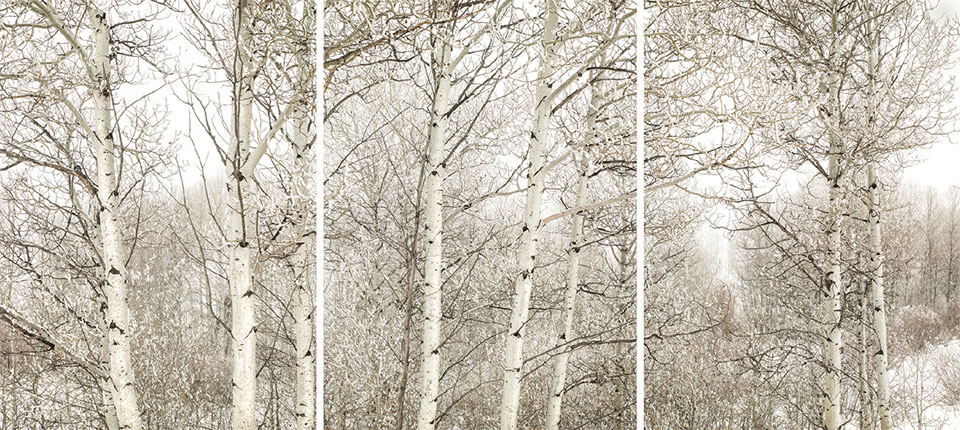
White on White | photograph on canvas | 48”x 110” (other sizes available) | James Bourret
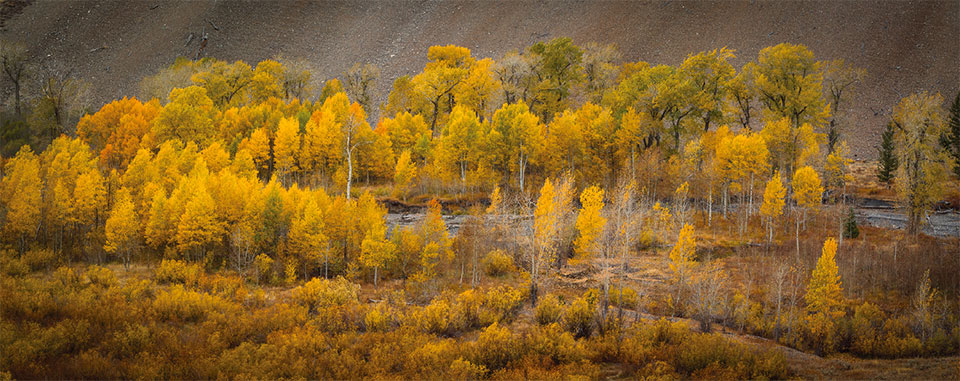
Trail Creek Sepia | photograph on canvas | 40”x 120” (other sizes available) | James Bourret
“Part of my motivation comes from wanting to share with others the beauty I have found through those experiences. Every new place is an inspiration, it’s the joy of finding something new that really drives me.”
–James Bourret
James’s work often depicts aspen forests—quintessential Mountain West scenery—but with textures and layered patterns, the images take on an abstract quality not usually associated with traditional landscapes. Portraying the truth and emotion of the landscape that he felt at the time of the exposure is a crucial element in James’s process. Through meticulous work with the image prior to its printing, he strives to reflect the mood, form, patterns, and colors of a scene.
“My photography is heavily influenced by my travels, but I think my most successful pieces aren’t defined by a specific physical location,” says James. “Rather, I want to convey abstract elements such as emotional impact and a sense of movement and change. The photos are more about creating depth than they are about the trees themselves as objects. I try to capture interesting spaces and invite the viewer to move into them.”
Not only is James’s background in architecture a valuable asset when it comes to photo composition, but he also believes that it gives him a greater understanding of the way art works within designed interior settings. He is exceptionally skilled at producing ultra-large, fine art photo installations for any home environment. Most of his triptychs are printed on canvas and hung without a frame to accommodate their scale and eliminate any competition from glass or reflections.
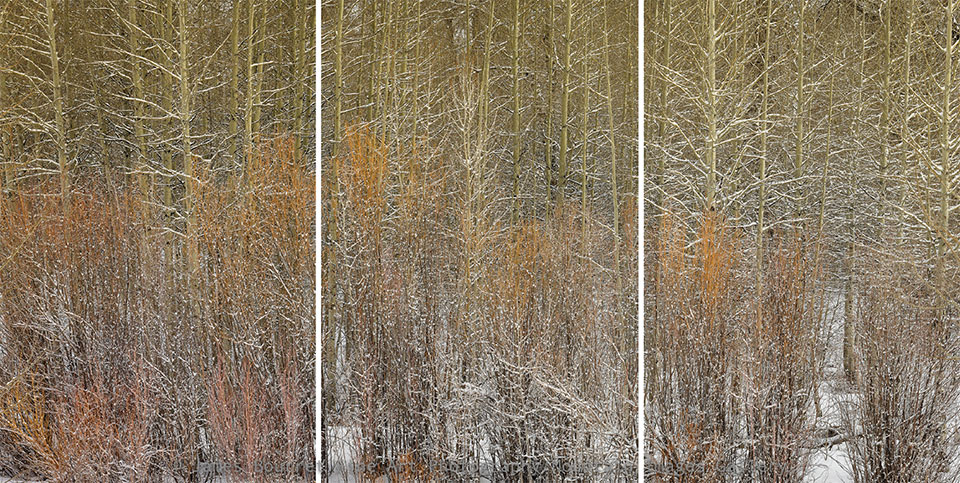
Aspenwillow | photograph on canvas | 60”x 120” (other sizes available) | James Bourret
“My photography is heavily influenced by my travels, but I think my most successful pieces aren’t defined by a specific physical location. Rather, I want to convey abstract elements such as emotional impact and a sense of move-ment and change. The photos are more about creating depth than they are about the trees themselves as objects. I try to capture interesting spaces and invite the viewer to move into them.”
–James Bourret
And James works directly with homeowners and designers to ensure that every one of his pieces is tailored to the space it will reside in, making size and media recommendations as well as providing full-service installation if desired.
“I really enjoy the process of collaborating with clients to learn their desires for their homes and helping them select and properly size a bespoke print that suits their aesthetic interests,” says James. “I try to customize my work in a way that meets the needs of each individual space and creates a truly unique experience in every home.”
Residing in the Valley for more than 20 years, James has a strong connection to the local environment. By producing immersive pieces that define the character of a room and transform spaces, he hopes to increase awareness and advocate for natural conservation and preservation. His work can be seen in the Courtyard Building across from the Ketchum Town Square as well as in his gallery, Mountain Images Gallery, on East Avenue in downtown Ketchum.
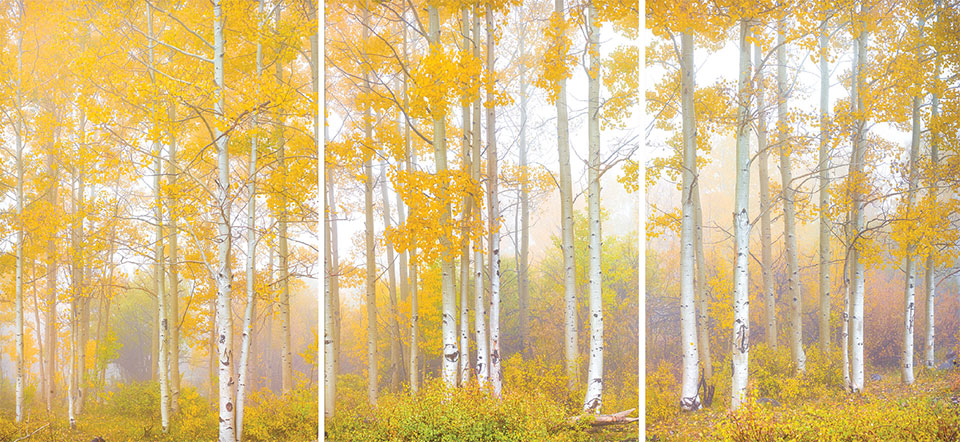
Aspens in Fog | photograph on canvas | 60”x 124” (other sizes available) | James Bourret
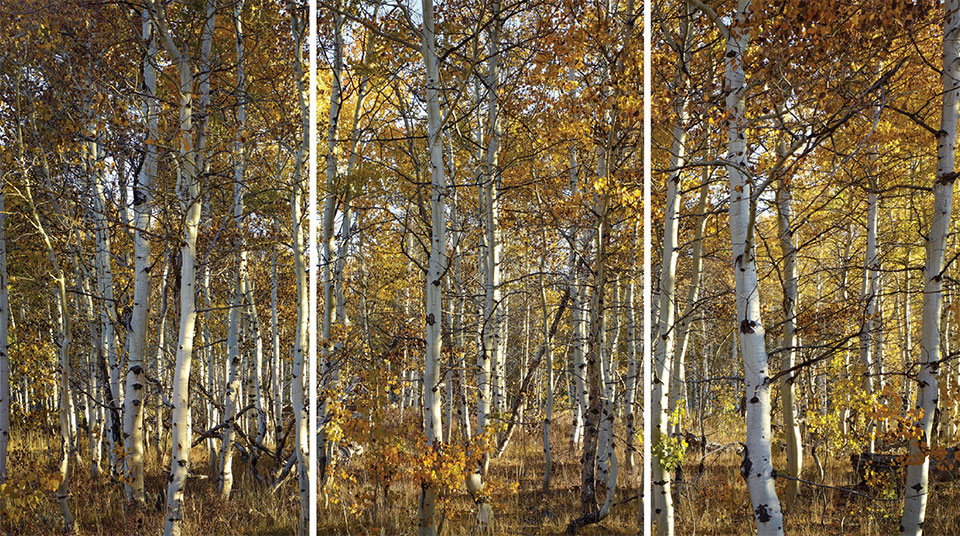
Last Leaves | photograph on canvas | 60”x 120” (other sizes available) | James Bourret
Scott Harder Reframes His Life
Fine art framer, conservator, and restorer writes a new chapter
by Sabina Dana Plasse
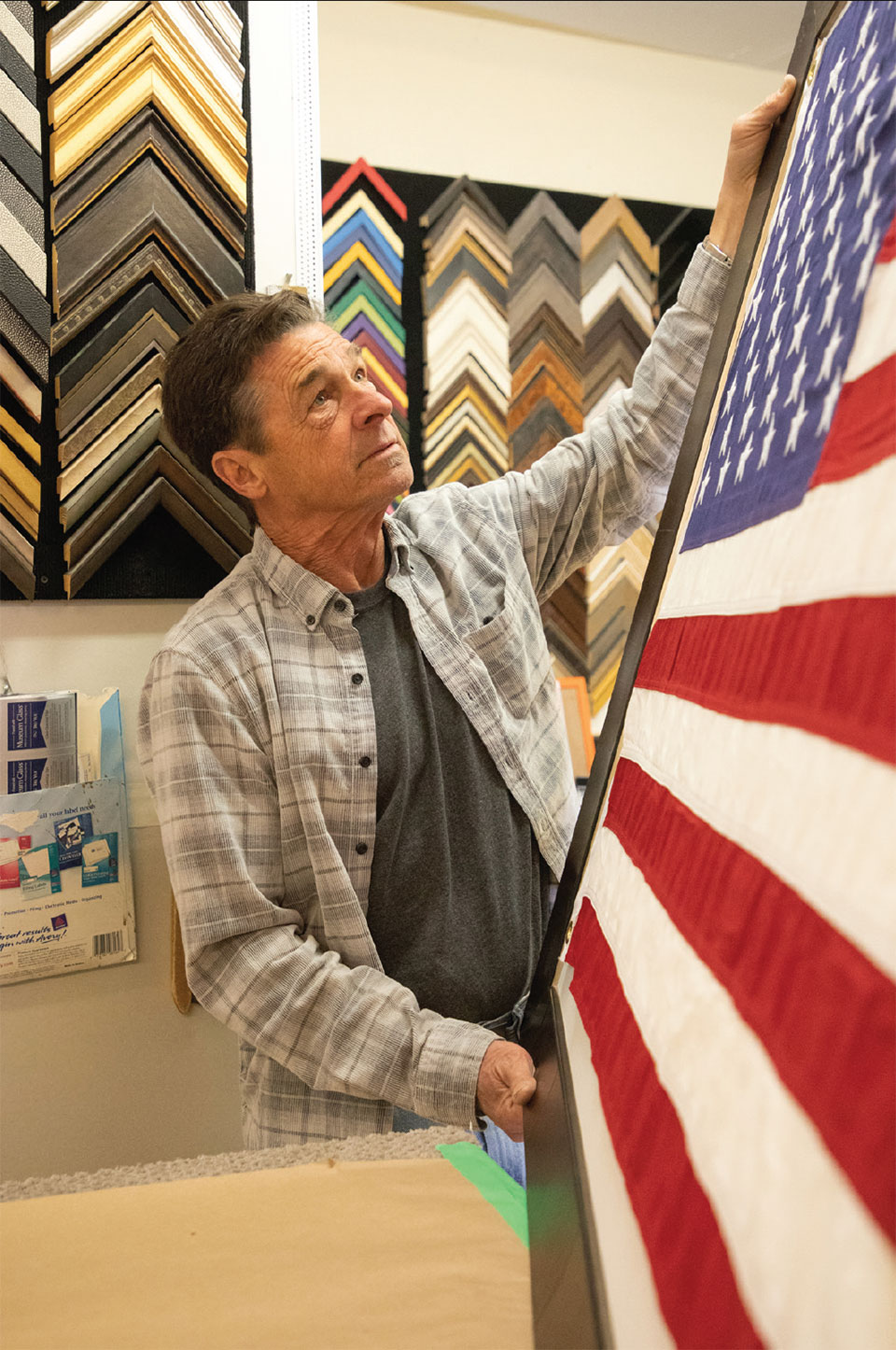
In 1972, William Scott Harder was 18 years old. He had only recently graduated from Junipero Serra High School in San Mateo, California, and had been hitchchiking his way around the country when he landed in Ketchum, Idaho. As an artist, he was drawn to the area’s dramatic beauty. Scott grew up in a very athletic environment with three brothers and all three shared a similar Jesuit education.
“I was always interested in the arts,” says Scott. “However, art was not available at Serra, so I had the opportunity to pioneer an art exchange program with Mercy High School, an all-girls school. The exchange program was a very novel concept for its time.”
Scott went on to study art at Chico State, UC Davis, and UC Santa Cruz, which provided the groundwork for his professional career as an artist and picture framer. In addition, Scott immersed himself in Sun Valley’s ski culture and worked as a line cook, waiter, dishwasher, bartender, picture framer, and sign maker.
“Even 40 years ago, you needed more than one job to survive,” he says. “When I finally moved to Ketchum in 1976, I painted and exhibited. Then, in 1978, I started framing to display my work.” As a picture framer for Gemini Art, Images Gallery, and Gallery 601 in Boise, where he attended graduate school at Boise State University, he gained the experience and confidence to open Scott’s Frame and Mat in 1985.
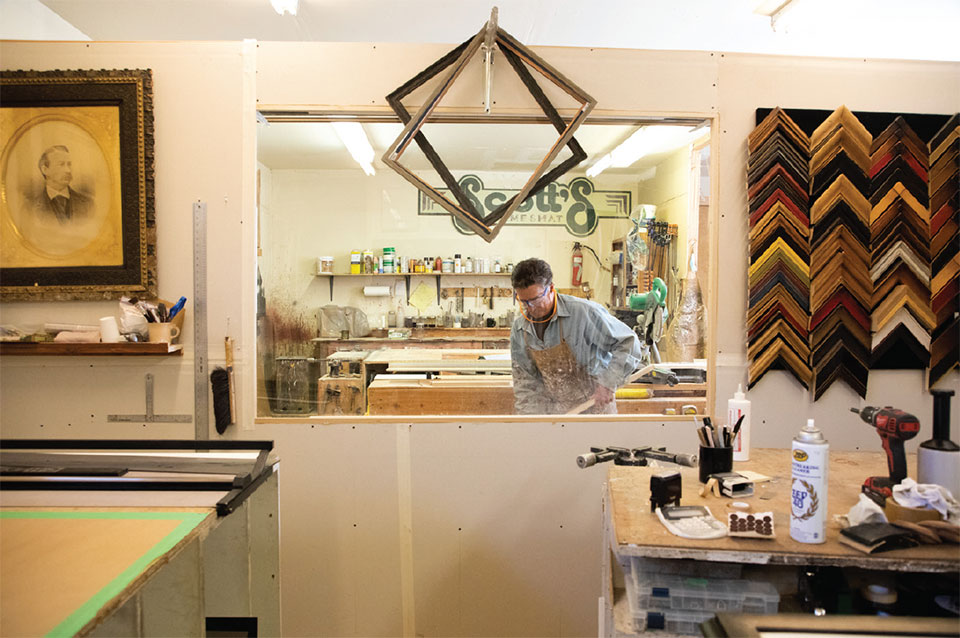
“There’s no question about it. For me, Sun Valley is the last great place.”
-Scott Harder
As vital as ever, Scott moves seamlessly around his recently converted workshop, working on multiple projects and disciplines simultaneously with soothing classic rock music playing in the background. Throughout his decades in business, Scott has amassed a plethora of techniques and solutions. His current location exists directly under his old shop. Scott is a master framer, conservator, and restorer. He knows all the tools of his trade, including the chemistry needed to mix oils, stains, and finishes that support fine works of art. He applies gold leaf to frames, carves, and brings damaged canvases back to life. The magnitude of applications that Scott can throw down in a moment is like watching a scientist at work, but for art.
For the last two years, people have spent a great deal of time at home looking at their surroundings, including their art. “COVID-19 changed everything,” says Scott. “This past December, I ended up closing my shop for the first time ever. When I re-opened in January 2022, I recreated a downstairs workshop, building walls, moving tables, and constructing new space.”
Scott has numerous tips and suggestions as a framer and conservator of fine art for many collectors. His advice has made a difference for many. As a result of the pandemic, Scott received frequent questions about art and how to freshen it up. Well-studied and experienced in caring for and handling valuable fine art, Scott is an expert to call for all your art needs.
“Whether it is simply moving a work of art to a different location, cleaning it, updating the frame package, or obtaining a condition report, you can experience a whole new perspective on your art by following these simple steps,” Scott explains. “If you need help moving or repositioning your pieces, call me, the Art Doctor. I’ve got the tools and know-how to make all art collections look their very best and stay protected to retain their value.”
Along with his heartfelt appreciation for fine art, Scott loves mountain town living equally. “I was fortunate to raise my three kids in Sun Valley, and I share my stoke for being here. I love being on the water. I love the mountains. I love to ski and this year’s end-of-season rollers on Warm Springs set up GS turns like it was the 1980s,” he says with nostalgia. “There is no question about it. For me, Sun Valley is the last great place. As a longtime resident, I think that we have all been the beneficiaries of an amazing transformation, and I’m truly grateful. So, for me, this is the last great place. Shhh…”